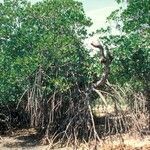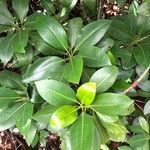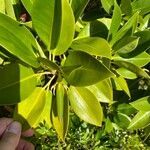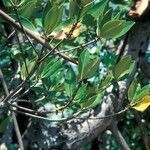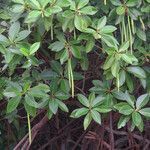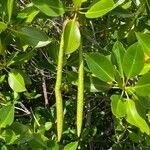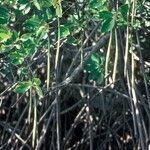Tree up to 27 m tall, rarely over 30 m by 70 cm diam. Branching not distinctly sympodial. Leaves broad-elliptic to oblong, (8½-)11-18(-23) cm by 5-10½(-13) cm, apex ± blunt to ± acute, base cuneate; midrib green beneath; petiole 2½-5½ cm, green. Stipules 5.5-8.5 cm long. Inflorescences 2-3 times forked, each arm with an apical involucre, 2-5(-12)-flowered; peduncles 2.5-5 cm; pedicels 4-8 mm. Free parts of the bracteoles at the base of the flower distinctly 2-lobed, lobes deltoid, acute or obtuse. Buds emerging from the bracteolar involucre long before the falling of the sustaining leaf. Mature buds widest near the base. Calyx 13-19 mm long, deeply lobed, lobes ovate, in anthesis pale yellow, c. 13-15 by 5-7 mm. Petals 9 mm long, densely hairy along the margins, partly clasping the epipetalous stamen with these margins, sparsely hairy on the back, hairs up to 3 mm. Stamens 8, sessile, 4 epipetalous, 4 episepalous, anthers 6-8 mm long. Free part of the ovary high-conical, in anthesis already emerging far beyond the disk, 2.5-3 mm high; style 0.5-1.5 mm, 2-lobed. Mature fruit elongate ovoid, with hardly contracted apex and often rugose base, dull brown-green, 5-7 by 2.5-3 cm; cotyledons 2-4 cm protruding; mature cotyledons green; hypocotyl cylindric, strongly rugose, 36-64 by 1¾ cm.
Evergreen, mangrove tree or shrub, 10-18 m high. Leaves opposite, ovate or elliptic, acuminate, leathery, midrib produced into a caducous mucro; stipules lanceolate. Flowers in axillary 1-3-flowered, pedunculate cymes. Calyx 4-or 5(6)-lobed, leathery; tube short; lobes oblong or ovate. Petals 4(5), arising at base of fleshy disc, lanceolate with inflexed margins, entire, sometimes woolly, sometimes with stalked gland at apex; pedicels long, thick. Stamens 4 opposite to sepals, 4 opposite to petals; filaments short; anthers lanceolate, apiculate, many-thecous. Ovary half-inferior, 2-locular, with 2 pendulous ovules per locule; style conical. Flowering time Aug.? Fruit a leathery, ovoid, obconic, or cylindric berry, surrounded by persistent calyx at base. Seed 1 by abortion; embryo germinating on plant, hypocotyl of germinating seed not ridged.
Trees, to 27(-30) m, d.b.h. to 70 cm. Stipules 5.5-8.5 cm. Petiole 2.5-4 cm; leaf blade broadly elliptic to oblong, 8.5-16 × 5-10 cm, base cuneate, apex ± blunt to ± acute. Inflorescences 2-4(-8)-flowered cymes; peduncle 2-5 cm. Flowers sessile. Calyx lobes ovate, 9-14 × 5-7 mm. Petals lanceolate, 7-9 mm, fleshy, partly embracing stamens, margins pilose. Stamens 8, 4 borne on base of petals, 4 borne on sepals, 6-8 mm; anthers sessile. Ovary emerging far beyond disk, free part elongate-conic, 2-3 mm; style 0.5-1.5 mm. Fruit dirty brownish green, elongate-ovoid, 5-7 × 2.5-3.5 cm, basally often tuberculate, apically slightly contracted. Hypocotyl cylindric, 30-60 cm. 2n = 36.
Tree to 15 m high (in Australia); bark brown. Leaves broadly elliptic to obovate; lamina 11–20 cm long, 5–11 cm wide, bright green, evenly brown-spotted underneath; petiole 2–4 cm long. Inflorescence usually 2–4-flowered, occasionally 1-or up to 12-flowered; bracteoles united at base, smooth; pedicels 4–8 mm long, terete. Petals 8–10 mm long, involute, villous along margins. Stamens 8, 4 at base of petals and partly enclosed by their involute margins, 4 at base of sepals; anthers 6–8 mm long, sessile. Ovary tapered upwards for 2–3 mm above disc at anthesis; style 0.5–1.5 mm long; stigma 2-lobed. Fruit usually 4–6 cm long. Hypocotyl 40–80 cm long, acute.
A medium sized tree. It grows to 30 m high and spreads to 3 m across. The stem is erect and branching. It has branched stilt roots. The leaves are leathery, oblong and shiny. The tip of the leaf ends in a slender thorn like extension of the midrib. Leaves are 10 cm long. The flower stalks are among the leaves and as long as the leaf stalks. Flowers are small. The leaf stalks are white to cream. The fruit are pear shaped and brown with a brown rough surface with glands. The hypocotyl is long and cylindrical. It is 20-40 cm long and 1.5-2 cm wide.
